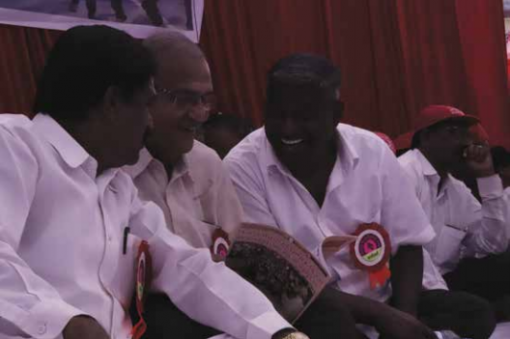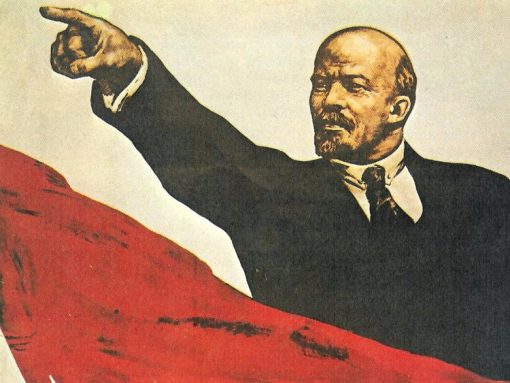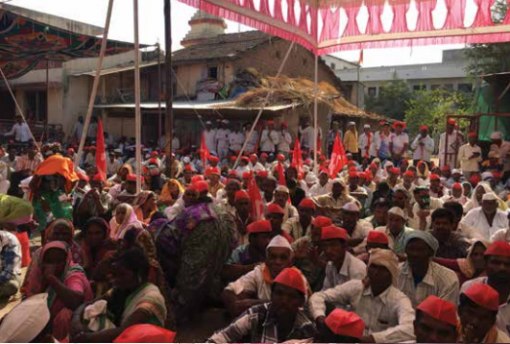“One of the key allies of the All India Kisan Sabha in the Long March was the BharatiyaShetkariKamgarPaksha (Peasants and Workers Party of India; PWP). The General Secretary of the party is Jayant Patil, a member of the Legislative Council of Maharashtra. Patil referred to the arrogance of the Bharatiya Janata Party (BJP) in thinking that they had wiped out the red flag with their win in the Tripura Assembly Elections. “Come here and see,” he roared, “this is a sea of red here.” As if on cue, hundreds of red flags started waving. “You think you can destroy the image of Lenin we carry in our hearts? We will erect a statue of Lenin in Alibag [Raigad district, near Mumbai; this is the main base of the PWP], and we will ask every political party to join us in doing this. By pulling down one Lenin statue, they don’t know how many more statues they have helped in erecting.”
– Sudhanva Deshpande, “Afterword”, The Kisan Long March in Maharastra
Lenin had called May Day the Workers Holiday. Sudhanva Deshpande, in the excerpt above, recounts how Lenin was invoked by one of the key organisers of the Kisan Long March. The March was a historic procession by 40000 farmers who walked from Nashik to Mumbai in Maharashtra, with a set of demands for the Chief Minister of the state. (Read more about the March here.)

Jayant Patil, in the excerpt published here, is referring to the visuals of Lenin’s statue being brought down in Belonia, Tripura, after the Left Front lost the elections in the state. Here, we publish complete interviews we had conducted while writing of this incident. The interviews are with Prakash Karat, Central Committee member of the CPI (M) and author of the Introduction to Lenin in 1917; Vijay Prashad, editor of LeftWord Books; and Suchetana Chattopadhyay, historian and professor at Jadavpur University, Calcutta,
Prakash Karat: “The RSS will naturally say Lenin is a foreigner because they were not interested in fighting the British; their enemies were the Muslims”
Souradeep Roy (SR): What was the impulse behind bringing out the book Revolution! Lenin in 1917 in 2017?
Prakash Karat (PK): At LeftWord Books, we were planning a series of titles commemorating the centenary of the October revolution. So, as part of that, one of the ideas proposed was to focus on Lenin’s writings in the year 1917. As you know, Lenin had written so much that his collected works run into 50 volumes.
The year 1917 is crucial because that’swhen the two revolutions took place. First, the February Revolution and then, the October Revolution. So, basically, I edited this volume taking a selection of his writings between February and October, i.e., between the two revolutions. I wanted to show how Lenin’s theory and practice unfolded at a crucial time of the revolutionary movement. From that, I could extract what has later become known as Leninism.
SR: In fact, there is one important section where you say, “The most persistant and obvious way has been to reduce Lenin to a Russian phenomenon. This is done to negate the universal significance of October.” Recently, there have been four figures whose statues have been vandalised— Lenin, Periyar, Maulana AbulKalam Azad, and B R Ambedkar. Even though some people will condemn the attack on Ambedkar, Periyer and Azad, a lot of people seem unconvinced with Lenin because they say he is not an Indian.
PK: When the Lenin’s statue in Belonia in Tripura was destroyed, or toppled, one of the BJP leaders made that precise point: if it had been an Indian leaders’ statue, we would have not done anything to it. This is a foreigners’ statue; what it is doing in India.This was his argument.
As I said in the book, Lenin has a universal significance; he is not just a Russian phenomenon. Lenin said this revolution is apart of the world revolution. It’s not just the Russian Revolution; it is a part of what he called as the world proletarian revolution. So, if you read Lenin’s writings from1917, you will find that he is talking about the Russian revolution in the context of the international movement. And why Lenin is relevant for India is that he was the first Marxist to draw in the colonial countries into the world revolutionary movement. He linked the movement of the working class, and the proletariat of the advanced capitalist countries, with the struggle for national liberation of the Third World countries or the colonial countries. He said the fight against imperialism is being carried out in both spheres: by the working class in the most advanced capitalist countries and by the oppressed colonial peoples. So, he made the Russian Revolution a part of that [anti-imperialist movement]. Russia, you see, straddled not just Europe; Russia was part of Asia also. And much of the tsarist empire, in terms of territory and the geography, could be considered as oppressed colonies—like Uzbekistan, or Tajikistan, or all the Armenia. All these countries were seen as part of an imperialist empire. Lenin was talking about imperialism in general. Russia is the weakest link in the imperialist chain so we can break it here, he argued. He brought in the world-wide struggles in which the key factor was the national liberation struggles in countries like India, China, and in other Asian, African, and Latin American countries.
The reason why Lenin is still looked up to in India, even outside Marxist and Leninist circles, is that the Indian freedom fighters and Indian revolutionaries were influenced by the Russian Revolution, which he had led. They could immediately relate to what happened in Saint Petersburg on November 7. They said, here are a people of reason against imperial monarchy; we are also fighting against imperial monarchy. One of the first poems written in India on the Russian Revolution was by the great freedom fighter SubramaniaBharathi, a Tamil poet. In the poem, he talks about all the people who have overthrown the king. He relates to that. He says, we are trying to overthrow the king of the British empire. Across the fold—from Bal GangadharTilak to SubramaniaBharathi to revolutionaries who were outside the Congress fold—all of them looked upto the Russian Revolution. In fact, when Bhagat Singh and his comrades were being tried, on Lenin’s birthday—Lenin had died by then—they collectively sent a telegram to Moscow sending greetingsfor Lenin’s birthday. They did it from the court. They did not have the facility to do that from jail. That telegram is still available. They hailed Lenin as a liberator of humanity or working people. This was the impact that Lenin and the Russian Revolution had. Rabindranath Not only political leaders but also cultural writers and personalities, like Rabindranath Tagore, all of them were tremendously impacted.And it had a very important role in stimulating our anti-imperialist struggle and movement in India. That is why Lenin is not seen somebody as an alien byall those who have anti-imperialist patriotism.
Of course, the RSS was not a part of this anti-imperialist struggle at all. They played no role in the freedom struggle. Unlike them, from the peoonein the Congress to the revolutionaries, all of them were impacted by the Russian Revolution.
The RSS wasnot really interested in fighting the British; they were more interested in fighting the Muslims. For them,naturally Lenin is foreign and alien
SR: One thing that you emphasise throughout the Introduction is the need for revolutionary praxis to be matched by revolutionary theory. You say he could read the events and foresee some kind of a predictable outcome. You, in fact, draw the trajectory of his thought from Imperialism, the Highest Stage of Capitalism to State and Revolution. You write: “How new forms of revolution will take place will depend on the theoritical advances made, and the revolutionary praxis will emerge.” Do you think that now, in India, we can think of newer modes and ways?
PK: That’s obvious. And it’s true not only for India. In fact, I think it’s true for the rest of the world too. The unique characteristic of Lenin in 1917 was that he went beyond his own theoretical framework. Lenin always said, “Without a revolutionary theory, there can be no revolutionary movement.” You will find that before February 1917 February, there is lot of theoretical hair splitting that Leninists were doing between the Mensheviks and the Bolsheviks. Leninhad to take on Social Democrats,like Plekhanov, in his own country. The German Social Democrats where the dadas in the Marxist and the Leninists had to take them on. Trotsky was was plucked out of his own country for being relentless, as far as his
theory was concerned. We must have the right, or the correct, revolutionary theory.We cannot compromise on that. But when the movement began or when it went into action, the practice which his fall out that the theory would not constrain it. He would break the barriers of the theory.And this happened again and again in 1917. It had come down later.But at one pointhe had said, “All parts of the soviets” was a slogan. After the February revolution, half way, he declared that there was no point in the slogan, give it up, citing the changed circumstances for his decision. Theoretically, it is a fine slogan.But they are out to crush usand there is no question of getting us. If the Mensheviks hadn’t the backed us, it would not have been possible. So, his theory was not very rigid, it was flexible. The other thing that he always said was “Theory is grey and practice is green,” i.e., evergreen. So theory remains a gray, amorphous thing unless you are able to practice it or apply it to put it into effect.
In fact, 1917 is a good example of how Lenin could so ably combine theory with practice, and learn from that practice.And, if necessary, modify or change the theory. If you see that as Lenin’s revolutionary praxis, then in the 21st century—in which we are living—in every country, including India, we have to constantly re-look at theory, renew and renovate our theory and practices. Wefind ourselves in a situation where, in ourown country and society, wehave to constantly update and improvise our theory and practice.
SR: Do you think that we have evolved some kind of a new theory?
PK: Well, there is no doubt that there is a big gap between what our updated theory should be and what it is. Are we coping with the tremendous changes in the world, in society, in terms of, say, science and technology? There is a very valid argument that Marxist theory has fallen behind in coming to grips with major changes and transformations, and coming up withtheories that keep up with these changes. This is one area. The other is the practice. This is also falling behind: the forms of struggles, movements, mobilisations—thathas not changed,there has been noinnovation. It’s a very complex area. But there are so many areas which open up.
Suchetana Chattopadhyay: “Lenin received the kind of respect which Sun Yat Sen and Kemal Pasha earned among the anti-imperialist Bengali intelligentsia in the post-First World War period.”
Souradeep Roy: How was Lenin’s perceived in Calcutta after the October Revolution? I ask this especially because Maulana AbulKalam Azad’s statue was brought down some time ago and a translation of The Communist Manifesto in Urdu had come out in a journal he was associated with. Since you have extensively worked on Muzaffar Ahmad, will you be able to comment on how fair it would be to say that Lenin was seen as a “foreigner” in pre-independence Calcutta in the 1920s?
Suchetana Chattopadhyay: Lenin was perceived as a liberator of the working masses. He received the kind of respect that Sun Yat Sen and Kemal Pasha earned among the anti-imperialist Bengali intelligentsia in the post-First World War period. Irrespective of religion or place of location, these figures were revered and incorporated into the dream of future, of an India free of colonial rule and other kinds of exploitationsthat existed in Indian society. Lenin was seen as the figurehead of an egalitarian vision that wouldchange Bengal, India, Asia, and the world. He was seen as an inspiration of the anti-imperialist struggle.The Bolshevik government’s staunch support for national liberation movements in the colonies was greeted with joy and happiness. Any friend against imperialism was treated as one’s own, as opposed to the local supporters of the British, which included the ancestors of the current Hindutva brigade.
And if we go by their logic that anything foreign must be rejected, we must ask the SanghParivar to openly confess its links with British rule, German fascism, the US government, the IMF,theWorld Bank, and multinational corporations selling weapons of war. They too have deep “foreign” links of their own.
We believe that the earth belongs to humankind.The oppressors are the same everywhere.
“The key point here is that the Communists believed that all people should be free of colonial rule”: Vijay Prashad
Souradeep Roy (SR): Why was it important to bring an Indian edition of Lenin’s writinfs, and why did you choose the year 1917?
Vijay Prashad (VP): We published Lenin in 2017, with an introduction by Prakash Karat, because it was the centenary of the Russian Revolution. That was the primary reason. Later this year, in a few months, we will publish Selected Lenin, and then a special edition of What is to be Done?,again, with an introduction by Prakash Karat.
Today, there is a disorientation in the Left circles. There are many who believe that there is no need for such a party, that spontaneous action is enough to defeat reaction. Marxists such as us believe that this amounts to surrender to the forces of reaction.
We want to return to Lenin, to revisit Lenin, to recount the Leninist moment in order to steel ourselves for the fights against fascism and towards a socialist society.
No wonder that the RSS and the BJP – and other fascistic forces see the Left as their main adversary. Others will surrender. But we will not. Hence, the constant return to the theories of how to build these movements.These are what guide the key classes against barbarism.
SR: I have read your book Red Star Over the Third World. There has been a particularly pernicious campaign to brand Lenin as a “foreigner”. Considering the Comintern’s work in anti-colonial struggles throughout the early nineteenth century, how do you see these accusations as a historian?
VP: Lenin’s role in the Russian Revolution is unparalleled. He was able to absorb the ideas and emotions of the rank and file in his party as well as channel some of the demands of the workers and peasants. This close link with the electric tension in the key classes allowed Lenin to gauge the limitations of the February revolution and call for asecond revolution—an insurrection against the vacillation of the leadership towards the bourgeoisie and the landlords. Lenin demonstrated the importance of a vanguard party, a revolutionary party, and of the need for decisive action when necessary. If there is no revolutionary party, there is a tendency for the most reactionary forces to prevail during a crisis. Rosa Luxemburg’s slogan is apposite—Socialism or Barbarism. Socialism does not arrive on its own. It requires a revolutionary party to provide shape to mass upsurges. That is what Lenin proves.
Lenin played a key role not only in uniting the workers and the peasants, but in developing a theory of anti-colonialism. Tsarist Russia was known as a ‘prisonhouse of nationalities’. It was itself an imperial space. The Leninist policy of self-determination of nationalities was focused on the internal nationalities of the Tsarist empire. But the theory went outwards. It was extended to all of Asia, Africa, and, later, Latin America. The key point here is that the Communists believed that all people should be free of colonial rule. This was in 1917 itself. They were far ahead of the Europeans and the Americans, who believed in such feeble ideas as trusteeships and mandates. It was the confidence of the Bolsheviks that pushed the national movements,right from India to China, to make much more aggressive demands for freedom. Lenin should be a national hero in India. His aggressive anti-colonialism inspired not only Indian Communists, but also Indian nationalists—as I show in Red Star Over the Third World. Gandhi was inspired by Lenin. Tilak was inspired by Lenin. It was Lenin who defended Tilak. In fact, it was Lenin whowrote, referring toTilak’s imprisonment, that the “British empire is doomed” for having awoken mass struggles against it.






